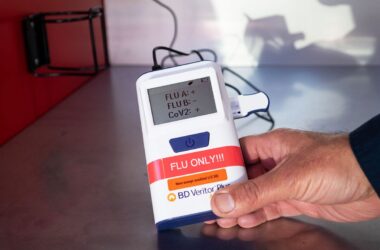Les douleurs testiculaires, les troubles de l’érection, la réduction du nombre et de la qualité des spermatozoïdes et la baisse de la fertilité sont des conséquences directes de l’infection, selon une nouvelle étude.
De multiples tissus de l’appareil génital masculin peuvent être infectés par SARS-CoV-2, reports a new Northwestern Medicine study in large animal models. The study, in SARS-CoV-2 infected-rhesus macaques, revealed the prostate, vasculature of testicles, penis, and testicles were all infected with the virus.
The surprising discovery was made utilizing a PET scan specially designed to reveal sites of infection spreading over time in a whole-body scan. Scientists didn’t know what they would find, but they expected to see the virus in the lungs and high up in the nose near the brain because people were experiencing loss of taste and smell.
“But the signal that jumped out at us was the complete spread through the male genital tract,” said lead investigator Thomas Hope, professor of cell and developmental biology at Northwestern Feinberg School of Medicine. “We had no idea we would find it there.”
“These results indicate that the testicular pain, erectile dysfunction, hypogonadism, reduced sperm count and quality, and decreased fertility associated with SARS-CoV-2 infection are a direct consequence of infection of cells of the male reproductive tract and not indirect mechanisms such as fever and inflammation,” Hope said.
Les preuves que l’infection par le SRAS-CoV-2 peut avoir un impact négatif sur la santé sexuelle et la fertilité des hommes s’accumulent chaque jour. Mais les scientifiques n’en connaissaient pas la raison et se demandaient si la cause était la fièvre et l’inflammation.
“Nous ne comprenions tout simplement pas pourquoi il avait cet impact négatif jusqu’à cette étude”, a déclaré Hope. Il a fait remarquer que des virus tels que les oreillons, Ebola, Zika, SARS-COV-1 et d’autres virus peuvent également infecter les tissus de l’appareil génital masculin et avoir un impact négatif sur la fertilité. L’infection par les oreillons est bien connue pour causer potentiellement la stérilité masculine.
La nouvelle étude montre comment le virus peut provoquer une pathologie dans la prostate, le pénis, les testicules et la vascularisation testiculaire (vaisseaux sanguins), a déclaré Hope.
L’étude est publiée sous forme de préimpression sur bioRxivce qui signifie qu’elle doit être considérée comme une recherche préliminaire jusqu’à ce qu’elle soit publiée dans une revue à comité de lecture.
“Même si cela ne représente qu’un petit pourcentage des personnes infectées, cela représente des millions d’hommes qui peuvent souffrir d’un impact négatif sur leur santé sexuelle et leur fertilité”, a déclaré Hope.
Les études cliniques suggèrent que 10 à 20 % des hommes infectés par le SRAS-CoV-2 présentent des symptômes liés à un dysfonctionnement de l’appareil génital masculin. Cela suggère que des dizaines de millions d’hommes qui ont été infectés par le SRAS-CoV-2, en particulier ceux qui ont eu de graves COVID-19, should evaluate their sexual health and fertility to determine if additional therapies could prevent or diminish future problems, Hope said.
“The potential impact of SARS-CoV-2 infection on sexual and reproductive health should be part of everyone’s decision to get vaccinated to minimize the chance of death, severe disease and hospitalization, and infection of the prostate, penis, testicles and vasculature (blood supply) of testicles,” Hope said.
This is the first PET (positron emission tomography) probe shown to be able to identify the sites of SARS-CoV-2 infection in a living animal, the study authors said.
“This approach allows the sequential scanning of the same animal, which defines the progression of virus dissemination and time before the virus is purged from the body,” Hope said. “It also has the potential to increase our understanding of long COVID and the development of novel therapies targeting different long COVID comorbidities.”
How the study worked
Early development of a fluorescently labeled version of the antibody-derived probe suggested a radioactive version of the probe would reveal the anatomical distribution of SARS-CoV-2 infection after a PET scan.
The observation of SARS-CoV-2 infection of the different tissues of the male genital tract emerges from a new system designed to use a PET scan to detect sites of SARS-CoV-2 infection in a rhesus macaque. The identification of the rhesus macaque as a major and reproducible site of SARS-CoV-2 infection was unexpected and has pathological characteristics consistent with the pathology of testicles of victims of SARS-CoV-2 infection.
Future research by Hope’s lab will:
- Examine male genital tract infection at later timepoints
- Determine if testicles are a reservoir for SARS-CoV-2 infection as has been suggested in literature
- Investigate if SARS-CoV-2 infects tissues of the female reproductive system
- Aid in the development of therapies and interventions to mitigate the impact of the COVID-19 pandemic on male fertility
- Goal to eventually do PET scan on patients to determine the location of the virus and the best course of care
Reference: “An immunoPET probe to SARS-CoV-2 reveals early infection of the male genital tract in rhesus macaques” by Patrick J. Madden, Yanique Thomas, Robert V. Blair, Sadia Samer, Mark Doyle, Cecily C. Midkiff, Mark E. Becker, Muhammad S. Arif, Michael D. McRaven, Lacy M. Simons, Ann M. Carias, Elena Martinelli, Ramon Lorenzo-Redondo, Judd F Hultquist, Francois J. Villinger, Ronald S. Veazey and Thomas J. Hope, 28 February 2022, bioRxiv.
DOI: 10.1101/2022.02.25.481974
Other Northwestern authors include Patrick Madden, Yanique Thomas, Sadia Samer, Mark Becker, Muhammad Arif, Michael McRaven, Ann Carias, Elena Martinelli, Judd Hultquist, Lacy Simons and Ramon Lorenzo-Redondo.
This research was funded by a “Notice of Special Interest” supplement for National Institute of Allergy and Infectious Diseases (of the National Institutes of Health) grant R37AI094595 for SARS-CoV-2 related studies.




